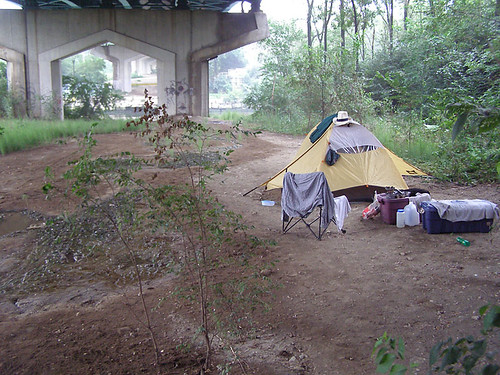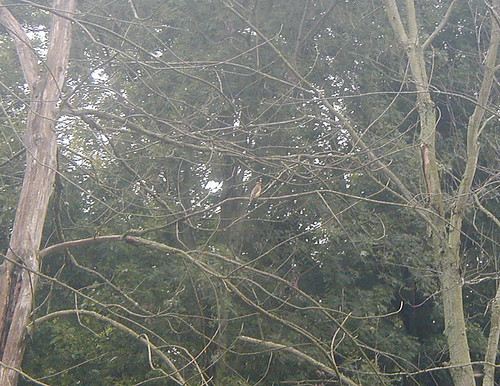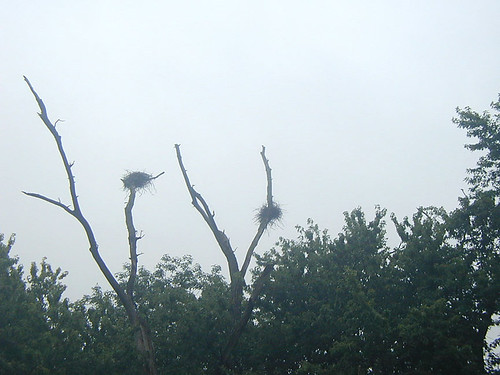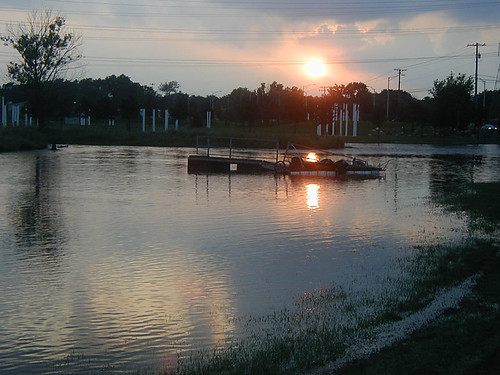In the exurbs the morning rush hour begins at 4am. The booms and bangs I'd taken to be thunder in the night increased and revealed themselves to be traffic over the plates of the bridge above us. It was a restless night of worries of where I have come from and what might lie ahead, tossing in the thick humidity of night under a creepy bridge.
A walk down to a nearby gas station turned up only Wonder bread and crummy carrot cake. So we decided to hike across the bridge into Willow Springs, on the prospect of finding the internet at a coffee shop. Turned out it was closed, but just getting out of the woods for a bit lifted my spirits and we found more appetizing breakfast at a new convenience store. From high up on the bridge we could see the three parallel water highways heading to Chicago: the original natural Des Plaines river, the old I&M Canal, and the current Sanitary Shipping Channel. All were filled with the same murky brown water and fallen logs, either still or in steady motion downstream.
Returning to the boat, we packed up and headed out into the channel again. The water had gone up again overnight so that it seemed easier to get out of the weeds than it had been getting in. A reassuring light drizzle let us know that we were back to life as usual.
The morning was a leisurely float around islands and meanders as the rain gradually drifted away. A flock of waxwings caught bugs in the air right in front of us. High in the treetops an osprey eyed us nervously. We passed several heron rookeries, with egrets by the dozen and herons of all sorts in the trees and along the shoreline.
One more bend and then our leisure came to an end. With the binoculars we could see a low railroad bridge set on many piers, clogged with flood-borne logs and the flash of whitewater. If there was no safe way through, our journey would be at an end. Visions of overturning and being sucked into a sieve of logs played in my mind. But we tied up on shore well above the bridge and walked a gravel road down to scout it out. We couldn't get too close to the water, just enough to see that there was a passage between the second and third piers open enough for us to make it through.
Donning our life jackets and battening the hatches, we pushed out onto the water again. How maneuverable would our boat be in dodging obstacles? It seemed such a slug when we were on the flatwater heading downtown. The portage proved the boat was heavier than when we'd started. And yesterday afternoon's landing attempt showed how little power we had to paddle against this current. Drifting closer to the chute there would only be one chance. Pointing the bow forward down we went. In midstream we decided the right passage around that log looked better than the left. Paddle, paddle! We hit the edge of an eddy behind the bridge pier and it bought us enough time to move around the log with only a bump of our tail. Whew! I was glad to move on and see that bridge gradually recede around the bend.
Suddenly across the river we caught a glimpse through the foliage of a sparkling tall white pyramid, an ornate Hindu temple, looking like some fantastic ancient jungle vision hovering in the greenery over the river. And then it was hidden again by trees and vines.
Pedalling on steadily again, even the more tangible towers of picturesque Lemont up on the bluffs to the south faded away as well. These towns along the Des Plaines grew up along the old I&M canal, not the river, so that they seemed remote, even inaccessible, to us as we passed on by.
Far ahead we could see another bridge. This one looked very high, a span soaring across the entire river valley on enormous pilings. At least we wouldn't have to worry about bumping our heads on this one. Looking at our charts we couldn't quite place where we were on the map or which bridge this might be. But as we drew closer and looked ahead with the binoculars we could see another bridge beneath it, crossed by construction equipment, and then it seemed like a dam spanning the entire river, piled up with logs. Were they damming the entire river to work on this bridge? What is going on? How could we get around this?
Landing the boat well upstream, we pushed our way through the thickets onto a dirt road and hiked on down to the construction site. It was a massive undertaking, and we realized that this was the new I-355 project connecting interstates 55 and 80, the newest, farthest flung ring road circling Chicago. Let loose the sprawl floodgates! South of here the monster freeway tears through farmland nearly to Joliet. Suburban commuters have been rooting for this pork project for a dozen years, but it will bring nothing but more than endless ticky-tack houses, Wal-Mart warehouses, wasteful pavement and acres of gridlocked traffic where there once was rich farming land.
A front-end loader bounced toward us as we reached the site. "That your Tom Sawyer raft or something?" the driver shouted down to us. We asked him about prospects about getting past the construction and permission to walk around. He seemed happy as a kid goofing around in his big rig, and offered to lift us over the dam on the front forklift. Or maybe that 700-ton crane over there, if we asked the driver, he could lift us high over the obstructions with hardly a thought. It seemed like fun. For the moment, however, we wanted to scope out the water.
The problem here was that the construction workers had built several low bridges across the river for driving their trucks under the bridge. "We don't see many boats coming down here," one worker told us. And no wonder: they had made no provision for boaters to get through at all. But worse, the floods had brought a whole raft of logs and driftwood that clogged up their bridges, damming the river and sending it spilling over into a side area where they were storing equipment. The river had come up two feet overnight, they said, and it seemed that much of their busy activity was to put stone weights on the bridges so that they wouldn't wash away, and rescue things that were suddenly underwater.
For a while we watched a supervisor trying to reach a stranded aluminum boat tied up in the rushing channel. First he drove a cherry picker out into the current, then lowered the boom over to the boat, got in the boat and secured it to the cherry picker instead. It seemed as convoluted and desperate a scheme as any of our ideas about getting around this obstacle, and in the end the forklift driver pushed his giant rig into the fast current up to the axles to lift the boat up and out of harms way. It was a dramatic scene, as I expected the forklift to be swept downstream in the fast current, but the workers seemed unhurried and without worries, and in a while all the trucks and cranes and boats were back on dry ground.
It seemed possible that we could portage across the dam if we could convince a few strong workers to help us lift the boat up and over. But the approach was blocked by logs and fast current, not a safe place to land by any means. When we inquired about specifics of lifting the boat with the forklift, the driver suddenly lost his spirit of fun. "You'll have to talk to my boss," he admitted. Standing on the bridge watching the rushing water and mulling our options, it seemed as if we might be stuck at last and at the end of our journey. A friend with a pickup truck had offered to haul us home whenever we were ready, and with a simple phone call we could end the trip.
So we headed back up the road to the boat. Along the way we found a better landing point, nearly at level with the road, and a path through the trees. Moving the boat there we pulled it up and went to work trying to straighten the mangled trailer wheel from the botched portage yesterday. By propping it on a rock and jumping on it, we managed to make it usable again. Sweating and working slowly we hauled the boat to the side of the road, lifted it up onto its wheels and hitched it back to the bike for another trip on land. What had seemed impossible was now doable, as we rolled on through the construction site past the cranes and trucks.
A small crowd of workers gathered around, pulling out cameras to take pictures and ask about our trip. Lowering the boat down a rough landing more slowly and carefully this time, we were soon reassembled and ready to go again. We felt more practiced at taking the trailer wheels and paddle wheels on and off, learning tricks to make it easier and smoother than before.
One of the workers had warned us of an impassible low bridge three miles ahead. We'd pass through a wide lagoon and then come to a series of islands, so we had better pick the correct channel to find the way through. For the moment we paddled on hopeful that we'd be able to continue, but not really knowing if the end of the trip lay just ahead.
Checking our speed with the GPS as we chugged along, we now found ourselves pedalling along at over 3 miles an hour! The flood was definitely picking up the current from the day before. More sprinkles added to the flow drop by drop as we continued.
Finally, rounding a bend we saw the first island. Which way to choose around it? But there some kind of a sign ahead. From the binoculars we could just make it out. "Canoe Landing to the Right". Aha, the first acknowledgment of any boat travel on this river! We had finally made it to Isle a la Cache, a landmark in voyageur days, and now site of a fur-trade museum.
So we chose the right channel and crept carefully around the island in the increasing current. Where was that landing? The water was moving fast enough now that there were no second chances if we missed it. I was imagining us landing at a real buckskin rendezvous reenactment, beaching our trashboat between birch bark canoes and having a dinner of frybread or Indian tacos cooked on an open fire. But it was a Tuesday evening, and nobody seemed to be around, and there were only flooded meadows that didn't even allow us to scope out the island before we continued.
Around the corner suddenly there was a low bridge, with the current rushing beneath. We had time to take down the hoops of our canopy and only inches to spare above our heads as we flew underneath and there was the landing to the left!
It was a city park of mowed grass now under water. We cut out of the fast water and drifted to a stop next to an inundated picnic bench. Stepping out onto the soggy park grass was a relief from the wild river, a reassuring bit of civilization. Nearby, a kid with glasses was obsessively working the shallows with a wide flat net. "Dad! Dad! I got another one, and its got legs!" he hollered. We peeked in their bucket and saw tiny silver minnows and fat tadpoles with stubby legs and wriggling tails. The man explained that he was a teacher, and that these bullfrog tadpoles took all winter to mature into frogs, so they made a great classroom project. The ones with front legs they threw back in the water, as these would mature by January when it would be impossible to let them go. In the wild, sometimes bullfrog tadpoles take two years to mature, and as adults they can become enormous, the teacher showed us with his hands in a circle.
Two kayakers were climbing into their boats and wiggling across the grass. "You know there's rapids downstream from here, don't you?" they asked. "I don't think your boat will make it, its got a lot of rocks in the river down there." Rapids?? Who knew there were rapids on the sluggish Des Plaines River? I guess we didn't do our homework very well. The farther we came from Chicago the more unfamiliar everything became, and it seemed we were foolishly ignorant of what we might be heading into. Mike at least was optimistic and confident. "I've never really been on the river at all in Chicago, so its all new to me!"
For now we had to find a place to camp. Sitting in the parking lot, pondering our options, a sheriff's truck pulled up. "That your craft in the water there?" the pair of cops asked. "You know the park's closing in an hour, you can't be there." Mike mentioned that we were looking for a place to camp for the night and the cops told us they had no idea. There was a state park 10 miles downriver, maybe we should just head on down there they suggested. So we waited until they left and hid the boat down in the trees around the bend near a flooded walking trail, then headed up the road to find something to eat.
After a relaxing dinner of delicious pizza in a strip mall that passes for downtown Romeoville, we walked back to the park in the darkness, down the flooded path to unload our things. We found a place hidden behind a fake Indian longhouse (made of fiberglass instead of bark) where nobody would see the tent and fell asleep on another sticky humid night.
Day 5 - Big River










Comments (1)
Matt--
You should syndicate this. Your reflections are fascinating. I hope you have at least a few warm, dry days portending autumn!
Posted by adele | August 28, 2007 9:22 PM
Posted on August 28, 2007 21:22